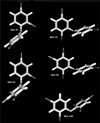Autism, Mitochondria and Polybrominated Diphenyl Ether Exposure
- PMID: 27071785
- PMCID: PMC5266592
- DOI: 10.2174/1871527315666160413122624
Autism, Mitochondria and Polybrominated Diphenyl Ether Exposure
Abstract
Background: Autism spectrum disorders (ASD) are a growing concern with more than 1 in every 68 children affected in the United States by age 8. Limited scientific advances have been made regarding the etiology of autism, with general agreement that both genetic and environmental factors contribute to this disorder.
Objective: To explore the link between exposure to PBDE, mitochondrial dysfunction and autism risk.
Results: Perinatal exposures to PBDEs may contribute to the etiology or morbidity of ASD including mitochondrial dysfunction based on (i) their increased environmental abundance and human exposures, (ii) their activity towards implicated in neuronal development and synaptic plasticity including mitochondria, and (iii) their bioaccumulation in mitochondria.
Conclusion: In this review, we propose that PBDE, and possibly other environmental exposures, during child development can induce or compound mitochondrial dysfunction, which in conjunction with a dysregulated antioxidant response, increase a child's susceptibility of autism.
Conflict of interest statement
The authors have no conflicts of interest to disclose.
Figures
Similar articles
-
Exposure to polybrominated diphenyl ethers (PBDEs) and child behavior: Current findings and future directions.Horm Behav. 2018 May;101:94-104. doi: 10.1016/j.yhbeh.2017.11.008. Epub 2017 Dec 7. Horm Behav. 2018. PMID: 29137973 Review.
-
Polybrominated diphenyl ethers in relation to autism and developmental delay: a case-control study.Environ Health. 2011 Jan 5;10(1):1. doi: 10.1186/1476-069X-10-1. Environ Health. 2011. PMID: 21205326 Free PMC article.
-
Prenatal and childhood polybrominated diphenyl ether (PBDE) exposure and attention and executive function at 9-12 years of age.Neurotoxicol Teratol. 2015 Nov-Dec;52(Pt B):151-61. doi: 10.1016/j.ntt.2015.08.001. Epub 2015 Aug 10. Neurotoxicol Teratol. 2015. PMID: 26271888 Free PMC article.
-
Mini-review: polybrominated diphenyl ether (PBDE) flame retardants as potential autism risk factors.Physiol Behav. 2010 Jun 1;100(3):245-9. doi: 10.1016/j.physbeh.2010.01.011. Epub 2010 Jan 25. Physiol Behav. 2010. PMID: 20100501 Review.
-
Clinical and Molecular Characteristics of Mitochondrial Dysfunction in Autism Spectrum Disorder.Mol Diagn Ther. 2018 Oct;22(5):571-593. doi: 10.1007/s40291-018-0352-x. Mol Diagn Ther. 2018. PMID: 30039193 Free PMC article. Review.
Cited by
-
Molecular Mechanisms of Polybrominated Diphenyl Ethers (BDE-47, BDE-100, and BDE-153) in Human Breast Cancer Cells and Patient-Derived Xenografts.Toxicol Sci. 2019 Jun 1;169(2):380-398. doi: 10.1093/toxsci/kfz054. Toxicol Sci. 2019. PMID: 30796839 Free PMC article.
-
Animal Model of Autism Induced by Valproic Acid Combined with Maternal Deprivation: Sex-Specific Effects on Inflammation and Oxidative Stress.Mol Neurobiol. 2025 Mar;62(3):3653-3672. doi: 10.1007/s12035-024-04491-z. Epub 2024 Sep 24. Mol Neurobiol. 2025. PMID: 39316355
-
Diagnostic and Severity-Tracking Biomarkers for Autism Spectrum Disorder.J Mol Neurosci. 2018 Dec;66(4):492-511. doi: 10.1007/s12031-018-1192-1. Epub 2018 Oct 24. J Mol Neurosci. 2018. PMID: 30357679 Review.
-
A Prospective Study of Environmental Exposures and Early Biomarkers in Autism Spectrum Disorder: Design, Protocols, and Preliminary Data from the MARBLES Study.Environ Health Perspect. 2018 Nov;126(11):117004. doi: 10.1289/EHP535. Environ Health Perspect. 2018. PMID: 30465702 Free PMC article.
-
Altered redox mitochondrial biology in the neurodegenerative disorder fragile X-tremor/ataxia syndrome: use of antioxidants in precision medicine.Mol Med. 2016 Oct;22:548-559. doi: 10.2119/molmed.2016.00122. Epub 2016 Jun 30. Mol Med. 2016. PMID: 27385396 Free PMC article.
References
-
- Zota AR, Rudel RA, Morello-Frosch RA, Brody JG. Elevated house dust and serum concentrations of PBDEs in California: unintended consequences of furniture flammability standards? Environ Sci Technol. 2008;42(21):8158–8164. - PubMed
-
- Coburn CG, Curras-Collazo MC, Kodavanti PRS. In vitro effects of environmentally relevant polybrominated diphenyl ether (PBDE) congeners on calcium buffering mechanisms in rat brain. Neurochem. Res. 2008;33(2):355–364. - PubMed
Publication types
MeSH terms
Substances
Grants and funding
LinkOut - more resources
Full Text Sources
Other Literature Sources
Medical

